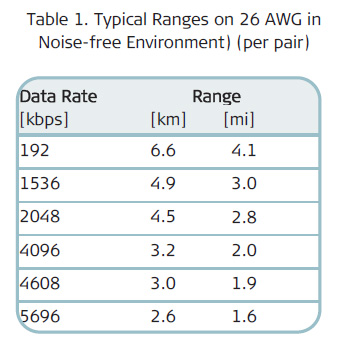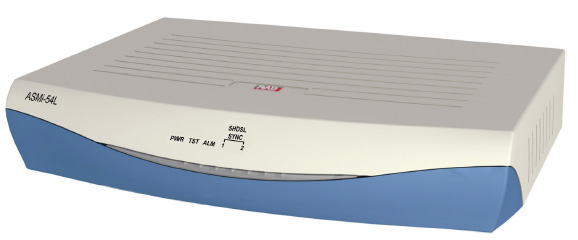
RAD
ASMi-54L SHDSL.bis Modem
Point to Point Modems for Data Delivery to Those Outer Edges of Your Coverage Footprint
Key-Points of the RAD ASMi-54L SHDSL.bis Modem
• Managed modem transmitting full-duplex at data rates of up to 5.7 Mbps over 2-wire
and 11.4 Mbps over 4-wire lines
• Dual Bearer mode for E1 and Ethernet HDLC
• Extended rates of up to 11.4/15 Mbps over 2-wire with RAD proprietary solution
• SHDSL bonding – for EFM: PAF according to IEEE802.3, for HDLC: M-Pair according to
ITU-T G.991.2
• 4-port 10/100BaseT interface with integrated Ethernet switch
• Full interoperability with Megaplex-4/LRS-102 ASMi-54C and ASMi-54C/N modules in
point-to-point application
The RAD ASMi-54L is a simple, cost-effective, dedicated managed SHDSL.bis modem that extends the range of high-speed services over existing copper pairs.
A special RAD proprietary solution provides the extended rates of up to:
• for EFM encapsulated data:15 Mbps over 2-wire lines (30 Mbps over 4-wire lines)
• for HDLC encapsulated data:
- Without E1: 15 Mbps over 2-wire
lines, 24 Mbps over 4-wire lines
- With E1: Depends on the number
of timeslots used
- Full E1: 8.5 Mbps over 2-wire lines,
12.2 Mbps over 4-wire lines
SHDSL/SHDSL.BIS UTILIZED IN THE RAD ASMi-54L
The modem employs TPS-TC framing 64/65o for EFM (IEEE802.3) and HDLC (G.991.2) on the SHDSL/SHDSL.bis link. ASMi-54L performs line probing according to G.991.2. When enabled, the DSL interface adapts its rate to the condition of the line (noise, loop attenuation, etc.). When disabled, traffic on the DSL line is transmitted at a fixed rate selected by the user.
The RAD ASMi-54L SHDSL/SHDSL.BIS modems can operate as a CO device or a
CPE device according to user
configuration.
The modem uses an Embedded Operation
Channel (EOC) for controlling and
monitoring the SHDSL/SHDSL.bis
repeaters. Up to eight SHDSL/SHDSL.bis
repeaters can be installed in line to
increase the operation range of E1- and
Ethernet-based modems.
EFM BONDING OF THE RAD ASMi-54L
EFM bonding on the Ethernet interface
ensures that a failure or addition of a link
does not drop the traffic being
transmitted over other wires in the group.
The capacity of the group does not
decrease when a new link is added at a
lower rate.
ETHERNET PORTS OF THE RAD ASMi-54L
ASMi-54L features up to four Ethernet 10/100BaseT ports with half/full-duplex, autonegotiation and flow control. The fault propagation functionality enables the unit to shut down the Ethernet user port when an SHDSL line failure is detected. LANs are connected by bridging. The internal forwarding of Ethernet traffic can be configured in two ways:
• By specifying the ports (a mode
identified as unaware in accordance
with Metro Ethernet Forum (MEF)
standards). In this mode, all the
Ethernet traffic reaching one of the
ports is forwarded to the other port,
and vice versa
• By using VLANs for classification:
(a mode identified as aware in
accordance with Metro Ethernet Forum
(MEF) standards). In this mode,
Ethernet traffic reaching one of the
ports is forwarded to another port in
accordance with its VLAN identifier
In VLAN aware mode, VLAN ID is presented
in the MAC table, and the packets can be
forwarded according to both MAC address
and VLAN ID.
TRAFFIC MANAGEMENT / QOS Wth ASMI-54L
802.1D, DSCP, Per Port, and Per VLAN
ID priority schemes allow users to define
different QoS levels according to
application requirements.
The ASMI-54L implements the IEEE's 802.1q
standards to provide VLAN-tagging with
four levels of prioritization, enabling
carriers to offer differentiated Ethernet
services.
VLAN tagging can also be employed to
separate traffic, ensuring transparency of
the customer traffic and bolstering
security of management traffic. The user
can activate or deactivate the priority
mechanism, and each priority (VLAN
priority, DSCP, per port, or per VLAN ID)
can be configured and mapped to one of
four priority queues.
Ingress data rate can be limited on each
Ethernet port.
ASMi-54L MANAGEMENT AND SECURITY
The ASMi-54L unit can be managed using
the following connections:
• Local RS-232 terminal
• Telnet server (with DHCP support),
SNMP (Ver.1)
• Web server
• Inband management with or without
dedicated VLAN.
RAD ASMi-54L management traffic is protected
with the Access Control List (ACL).
OAM
ASMi-54L complies with the IEEE 802.3ah
(IEEE 802.3-2005) standard for Operation,
Administration, and Maintenance (OAM),
originally developed for Ethernet in the
First Mile (EFM) applications. OAM is a set
of functions designed to monitor network
operation on an SHDSL line, in order to
detect line faults and measure
performance.
RESILIENCY WITH THE ASMi-54L
Dying Gasp condition occurs if there is an
interruption in the ASMi-54L power
source. ASMi-54L reports power failures
to the specified network management
stations by sending an SNMP trap. This
helps a service provider identify and
isolate the end-point device that
experienced a power failure.
PHYSICAL
ASMi-54L is supplied in 1U-high plastic or
metal 8.5 inch enclosures.
Modems in metal and plastic enclosures
can be mounted alone or in pairs in a
19-inch rack using RAD’s optional
mounting kits.
Both plastic and metal enclosures are
available in the extended temperature
versions (by special request).


